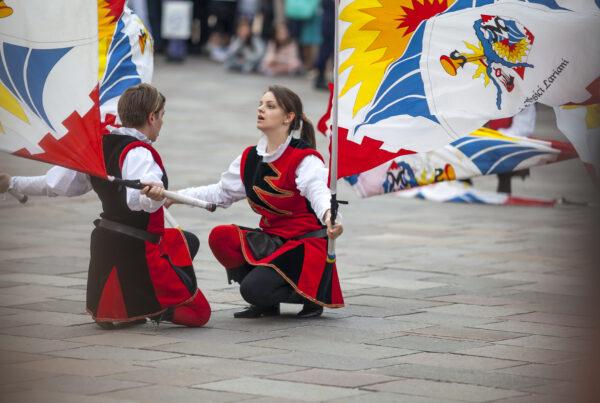The Age of the Communes
This age was characterized by recurrent struggles, between Como and Milan. The latter was jealous of Como’s prosperity and thus, for petty reasons, began a ten year war (1.117-1.127), which ended by the defeat of Como, the demolition of its walls and of the suburbs of Vico and Coloniola. The survivors were forced to move into shanty villages, but the vengeance against Milan was not far off. As a matter of fact, Como benefited from Barbarossa’s protection because from the onset, it had given him its allegiance against those communes (headed by Milan) which had liberal aspirations and wanted to free themselves from the Empire. In 1.158 Frederick Barbarossa was in Como. He and his army probably stayed in the Baradello Castle; what followed next is well known. Milan was destroyed and the Comenses authorized to pull down part of its walls. In 1.178 the battle of Legnano was fought and was followed by the Peace of Constance (1.183), whereby the Emperor granted self-government to the Communes. A peace treaty was eventually signed with Milan in 1.186.
comuneThe architecture of the Age of the Communes featured magnificent Romanesque churches.
SIGHTS:
San Carpoforo was probably built on a heathen temple, dedicated to Mercury – with crypt, elevated presbitery and a bowl-shaped vault with horizontally alternating light and dark stones. Sant’Abbondio is built on the foundations of the early Christian church of Saints Peter and Paul and characterized by two bell towers.
San Fedele is built on the early Christian church of Santa Eufemia and characterized by an unusual trefoil shape and its distinctive central plan (its apse, with aisle and accessible arches, is a quite exceptional feature).
San Giacomo, rebuilt in the 14th century, characterized by a beautiful semicircular apse
San Provino, a tiny and elegant temple. Alongside with the religious, the civil architecture experienced a remarkable development. In addition to the already mentioned Baradello Castle. Como had a Broletto, flanked by the Civic Tower, with a council hall and a balcony overlooking the Municipal Palace (the present elegant and refined building of multicolored marble is Gothic and was partially deprived of its southern side, to make room for the Cathedral). The city walls, destroyed at the end of the ten years war with Milan, were also rebuilt with the static, remarkably sober and imposing entrance of Porta Torre (40 mts. high).
The Signorie
In Como as elsewhere in Italy, the crisis of the Communes was brought by the struggle between Guelphs, who supported the power of the Pope, and the Ghibellines, who fought for the Emperor. Endeed, the civil strife went far beyond its political significance; in that it reflected personal rages, passions and interests of the most powerful families in the city. As far as architecture is concerned, the presence, in Como, of the two opposing factions of the Rusca and the Vittani was clearly indicated by the so called “tower-houses” (the “Demorata”, belonging to the Vittani, and the “Torre Rotonda”, belonging to the Rusconi), fortress-like houses with very few openings, built for defence purposes, particularly in the event of night attacks. In 1320, the Milanese Azzone Visconti was called in by the Comenses, who were worn out of the long seemingly endless struggle. He set up a “Signoria” in Como, where he distinguished himself for his professed patronage. Under his rule, a mighty fortress called “Cittadella” was erected in the middle of the urban structure of the town. Under Duke Galeazzo Visconti the building of the Cathedral began in the area where the Church of Santa Maria Maggiore once stood. For its building, the Duke himself exempted the city from taxation. The magnificent frescoes, on the chancel of the Basilica of Sant’Abbondio, were probably painted during Galeazzo’s rule.
Giotto’s style, which presumably arrived in Lombardy thanks to Giovanni da Milano and Giusto dei Menabuoni, emerges clearly in the role played by nature and architecture which, heralding the forthcoming humanistic culture, focused on man’s deeds.
Humanism and Renaissance
In spite of the political turmoil which accompanied the handing over of power from the Visconti to the Sforza, the 15th century saw a cultural change which focused increasingly on the classic world. In contrast to the Middle Ages, the emerging culture featured new intellectual expressions and aspirations.
Benedetto Giovio’s works provide tangible evidence of such thinking. Giovio was born, in Como in 1.417. He wrote the “Historia Patriae”, a chronicle of the events, which took place in Como from its origins to the Renaissance. His brother Paul was a bishop and although his demanding office made him stay away from Como, he did not neglect his hometown. Indeed, he gathered over 400 portraits of illustrious people in a museum. The splendour of the Renaissance emerged clearly also in architecture. The residences of the upper middle-class families (the Giovio, Olginati, Rusconi, Volpi, Pantera, Bazzi and Sangiuliani’s palaces) featured quadrangular plans, round arches and inner courtyards with porticoes supported by thin and elegant columns. During this time, the building of the Cathedral was for the most part accomplished. Only its dome had yet to be finished.
Religious played a major role, particularly Cardinal Branda Castiglioni, who closed down the small hospitals scattered here and there, to replace them with one single hospital called “Sant’Anna”, located then in Via Cadorna, where the Conservatoire now stands. Although often remodelled, Cardinal Branda’s residence, located in via Bianchi Giovini, in what is today the SIP building, still fascinates the passer-by.





